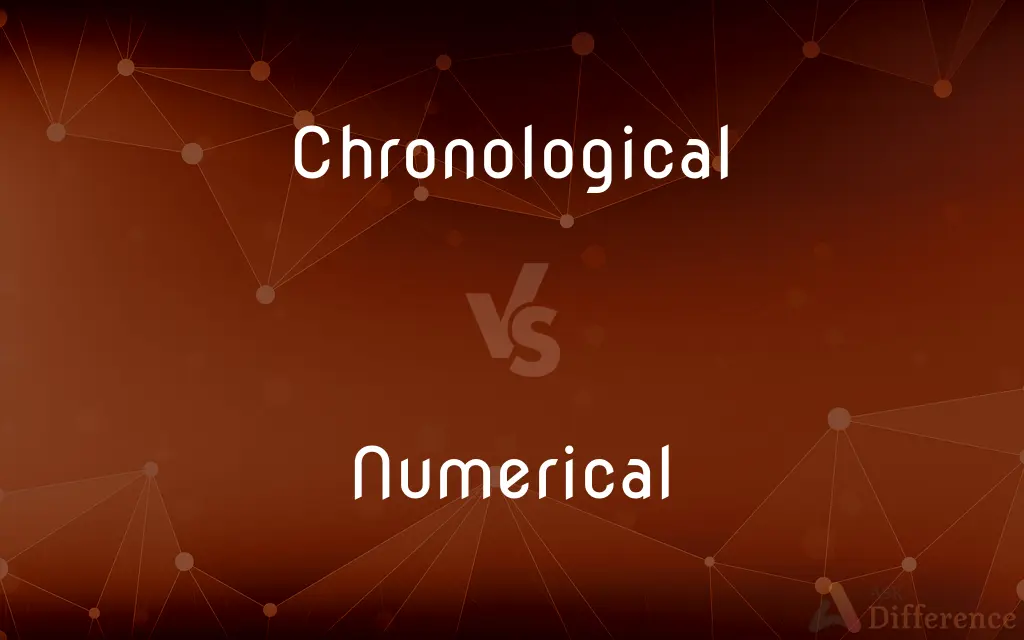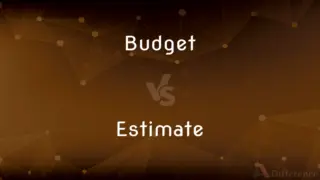Chronological vs. Numerical — What's the Difference?
By Tayyaba Rehman & Maham Liaqat — Updated on March 20, 2024
Chronological order organizes events based on their time sequence, while numerical order sorts items or data based on numbers.

Difference Between Chronological and Numerical
Table of Contents
ADVERTISEMENT
Key Differences
Chronological order is a method of arranging events in the sequence in which they occurred over time, making it ideal for timelines, histories, and narratives. It provides a clear progression from past to present or future, helping to understand the sequence and timing of events. On the other hand, numerical order sorts items or data based on numerical value, either in ascending or descending order. This method is used in organizing lists, statistical data, or any context where numerical comparison is relevant.
In chronological organization, the emphasis is on the flow of time and the sequential development of events or stories. This approach is particularly useful in historical studies, literature, and project planning, where the sequence of occurrences is crucial. Whereas, numerical organization focuses on the quantitative aspect of the items being arranged, making it suitable for mathematical, financial, or scientific data analysis, where the magnitude or size of numbers plays a key role.
Chronological order can help in understanding cause and effect, as it lays out events in the order they happened, revealing how one event leads to another. In contrast, numerical order is more about organization and hierarchy based on numbers, which can aid in quickly identifying the largest, smallest, or median values in a set of data.
While chronological order is largely temporal and best suited for narrative coherence and historical accuracy, numerical order is inherently quantitative, aimed at clarifying relationships between numbers or ranking items based on numerical criteria.
The use of chronological order versus numerical order depends on the context and the goal of the organization. Chronological is chosen for storytelling, historical documentation, and processes, highlighting the importance of time. Numerical order is preferred in contexts requiring the comparison, analysis, or categorization of data based on number values, such as in scientific research, financial reporting, or inventory management.
ADVERTISEMENT
Comparison Chart
Basis of Arrangement
Time sequence (past to present/future)
Numerical value (ascending or descending)
Primary Use
Timelines, histories, narratives
Lists, statistical data, rankings
Focus
Temporal progression and sequence
Quantitative value and comparison
Suitable For
Historical studies, storytelling, project planning
Mathematical analysis, financial data, inventories
Emphasizes
Sequence of events and timing
Magnitude, size, or rank of numbers
Compare with Definitions
Chronological
The sequencing of historical events from earliest to latest.
The museum exhibit displays artifacts in chronological order to depict the evolution of technology.
Numerical
Sorting data in ascending or descending order based on numbers.
The research data was organized in numerical order to simplify analysis.
Chronological
A method used in narratives to present events in sequence.
The novel unfolds in chronological order, enhancing the storyline's clarity.
Numerical
A way to manage inventory by categorizing items through their numerical codes.
The warehouse inventory was updated to reflect items in numerical order for efficiency.
Chronological
Organizing steps in a process according to the time each step takes place.
The instruction manual lists the assembly steps in chronological order.
Numerical
A method used in lists to prioritize or rank items by numbers.
The candidates were listed in numerical order based on their test scores.
Chronological
An arrangement of events in the order they occurred over time.
The biography was written in chronological order, starting from the subject's birth to their death.
Numerical
An arrangement of items based on their numerical value.
The books in the library are sorted in numerical order by their call numbers.
Chronological
A timeline arrangement that helps in understanding the progression of events.
The documentary presented the events of the war in strict chronological order.
Numerical
Organizing statistical information from smallest to largest values.
The financial report presented quarterly profits in numerical order.
Chronological
Arranged in order of time of occurrence.
Numerical
Of or relating to a number or series of numbers
Numerical order.
Chronological
Relating to or in accordance with chronology.
Numerical
Designating number or a number
A numerical symbol.
Chronological
Relating to time, or units of time.
He is 67 in chronological age, but has the mind and body of someone 55.
Numerical
Expressed in or counted by numbers
Numerical strength.
Chronological
In order of time from the earliest to the latest.
The live report lists all the events in chronological order.
Numerical
Of or pertaining to numbers
Chronological
Relating to or arranged according to temporal order;
Chronological age
Numerical
(obsolete) The same in number; hence, identically the same; identical.
Numerical
Measured or expressed in numbers;
Numerical value
The numerical superiority of the enemy
Numerical
Of or relating to or denoting numbers;
A numeral adjective
Numerical analysis
Numerical
Designated by or expressed in numbers;
Numerical symbols
A very simple numeric code
Numerical equations
Numerical
Relating to or having ability to think in or work with numbers;
Tests for rating numerical aptitude
A mathematical whiz
Common Curiosities
What is the main purpose of chronological order?
The main purpose is to organize events based on their time sequence, aiding in understanding temporal relationships and historical progressions.
How do chronological and numerical orders improve readability?
By organizing information logically, either through time sequence or by numbers, they make data and narratives easier to follow and understand.
Is chronological order suitable for every kind of narrative?
While widely used, it may not suit narratives that intentionally disrupt time sequences for stylistic or storytelling purposes, such as in some novels or films.
Can numerical order help in qualitative research?
Primarily, it's used in quantitative contexts, but it can help organize qualitative data that's quantified for analysis, like coded responses or ranked feedback.
Can chronological order be used in scientific research?
Yes, especially in case studies or when detailing the progression of experiments and their results over time.
What is the advantage of numerical order in data analysis?
It facilitates quick comparison, identification of patterns, and determination of rankings based on numerical values.
Can you combine chronological and numerical orders?
Yes, in complex data sets or narratives where both time sequence and numerical value are important, both methods can be combined for clarity and depth of analysis.
How does chronological order aid in understanding history?
It provides a linear progression of events, helping to understand causes and effects within historical contexts.
Are there limitations to using numerical order?
Its effectiveness is limited when numbers do not represent a hierarchical or comparative value, or when the focus is not on quantitative analysis.
Do chronological and numerical orders have universal applications?
While their applicability is broad, the choice between them depends on the specific goals of organization, whether understanding time-based sequences or analyzing numerical data.
Share Your Discovery

Previous Comparison
Budget vs. Estimate
Next Comparison
Suffering vs. TormentAuthor Spotlight
Written by
Tayyaba RehmanTayyaba Rehman is a distinguished writer, currently serving as a primary contributor to askdifference.com. As a researcher in semantics and etymology, Tayyaba's passion for the complexity of languages and their distinctions has found a perfect home on the platform. Tayyaba delves into the intricacies of language, distinguishing between commonly confused words and phrases, thereby providing clarity for readers worldwide.
Co-written by
Maham Liaqat













































